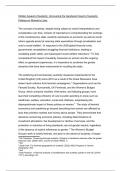Hidden Assault of Austerity: Uncovering the Gendered Impact of Austerity
Policies on Women's Lives
The concept of austerity, despite being subject to varied interpretations and
complexities over time, remains of importance to comprehending the workings
of the contemporary state. Austerity represents an economic as well as social
reform agenda aimed at reducing state expenditure through privatisation and
cuts to social welfare.1 In response to the 2008 global financial crisis,
governments recapitalised struggling financial institutions, leading to
escalating public debts, and subsequent social welfare reductions. 2 To fully
comprehend the impact of austerity measures on women and the ongoing
effect on gendered experiences, it is imperative to scrutinise the gender
dynamics that have been instrumental in moulding the state.
The polarizing and exclusionary austerity measures implemented in the
United Kingdom (UK) since 2010 as a result of the Great Recession have
drawn harsh criticism from feminist campaigners. 3 Organisations such as the
Fawcett Society, Runnymede, UK Feminista, and the Women's Budget
Group, which comprise charities, think-tanks, and lobbying groups, have
launched compelling criticisms of cuts to public spending in areas such as
healthcare, welfare, education, social and childcare, emphasising the
disproportionate impact of these policies on women. 4 The study of feminist
economics and academia go beyond describing how women are affected by
laws that prioritise markets and money above people. They demonstrate that
decisions concerning economic policies, including determinations of
investment allocations, the development or decline of services, and the
protection or reduction of living standards, are not gender-neutral, regardless
of the absence of explicit references to gender.5 The Women's Budget
Group's work is overtly feminist, and prior to the advent of austerity, it forged
1
Nik Theodore, ‘Governing through austerity: (II)logics of neoliberal urbanism after the global
financial crisis’ (2020) 42(1) Journal of Urban Affairs, 3.
2
ibid.
3
Sarah Hall, ‘For feminist geographies of austerity’ (2022) 46(2) Progress in Human
Geography, 300.
4
ibid.
5
Ruth Pearson, ‘A feminist analysis of neoliberalism and austerity policies in the UK’ (2019)
71(71) Soundings, 29.
, positive partnerships with feminist players in the political sphere. 6 Crucially, as
European governments work to reduce the size of the state, stop immigration,
and impose "austerity governance," the modern manifestation of
neoliberalism, it is becoming more urgent than ever to explicitly reassert
gender as a category of analysis and a material dimension of power. 7
This research paper aims to investigate the historical and contemporary
context and significance of austerity as a political objective, as well as its
ramifications on class and gender dynamics. Utilising feminist analysis, this
report will explore how the state has consistently exploited and stigmatised
working-class women in the pursuit of capital interests. As established
austerity policies yield far-reaching consequences in daily life, this report will
initially focus on examining the impact of austerity measures on women's
employment.8 Subsequently, it will discuss the adverse effects of welfare cuts
on women's access to social services. The COVID-19 pandemic and the cost-
of-living crisis have further intensified the detrimental implications of austerity,
underscoring the perils of post-pandemic austerity shock. This paper
concludes by arguing that the global financial crisis has caused and is still
reproducing practises of governance, which are made harsher by the
pandemic and the cost-of-living issue. It does this by adding to the vast body
of feminist literature. These methods further solidify a masculinized, white,
and elite culture of global financial privilege while marginalising feminist
concerns.9 The final section of this paper highlights three potential areas for
recommendations.
IMPACT OF AUSTERITY ON WOMEN’S EMPLOYMENT
This section will first discuss the disproportionate impact of austerity
measures on women's employment by examining two hypotheses. It will then
6
Janet Newman, ‘Regendering governance in times of austerity: dilemmas of research,
theory, and politics’, in Christine Hudson and Malin Rönnblom, Gender, governance, and
feminist analysis: missing in action? (Routledge 2017), 15.
7
ibid 1.
8
Hall n(3), 299.
9
Penny Griffin, ‘Crisis, Austerity and gendered governance: A feminist perspective’ (2015)
109(1) Feminist Review, 49.




